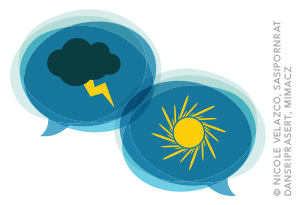
Step one: Don't ignore it.
Fam Pract Manag. 2018;25(2):48
Author disclosure: no relevant financial affiliations disclosed.

With all the pressures on doctors today to do more in less time, it is tempting to look for shortcuts throughout your workday. One ill-advised shortcut is to ignore patients' emotions during their visits.
Even conscientious physicians who are attentive and listen well to what their patients are saying can easily become focused on the cognitive aspects of the visit and miss the emotional layer just beneath the surface. Left unaddressed, negative emotions — such as Mr. Jones' tinges of anger or Mrs. Smith's constant worrying — can hinder the healing process and complicate the doctor-patient relationship.
Here are five pointers for identifying and addressing difficult emotions during patient visits:
1. Note nonverbal cues. Communication theorists tell us that most communication is nonverbal. We communicate through our posture, our facial expressions, our moods, our gestures, our eye contact, and so on. Even with verbal communication, our tone, inflection, and pace can reveal more than our words. When a patient says everything is okay but has a blank stare or an angry tone, we should not ignore these cues.
2. Bring up what is happening right in front of you. When we see a patient display a negative emotion during a visit, whether through nonverbal cues or otherwise, we need to address it or else the visit can begin to deteriorate. We might say to the patient who gives off angry cues, “Joe, it seems like something is really bothering you today. Would you like to talk about it?” When asking a “feeling” question like this, be prepared for a more intense expression of feelings, at least initially. Things may get worse before they get better. However, by getting the emotions out in the open, we can begin to address them.
3. Make gentle probes. When emotions are difficult, we should not approach the person like “a bull in a china shop.” Instead, for better results, speak softly and gently and give the patient some space. For example, “Sally, I sense that I may have done something to upset you, and if so I would like for us to discuss it. Am I correct, or could I be mistaken?” This type of language allows you to probe the issue with sensitivity, recognizing the vulnerability the patient may feel.
4. Verbalize empathy. Empathic statements can satisfy patients' needs for trust and security and communicate that you are with them in their frustration, pain, or anguish. Even statements as simple as “That must be very difficult for you” can ease their pain. Patients who feel fragile can be more reactive and volatile, but empathic statements can help them calm down and feel more secure.
5. Don't take it personally. When feeling frustrated or stressed by a patient's behavior, we must be careful not to escalate the problem by our own reactivity. These difficult situations are not usually about us but some other influence in the patient's life; we are just a convenient target. Even if we have made a mistake or unintentionally caused an emotional wound, taking a nonreactive and unanxious approach as the professional can help bring about resolution.
Addressing emotions can be a messy process. Some patients will need more help than we can provide at the current visit or ever, so follow-up care or a referral might be necessary. However, many patients simply need someone to acknowledge their feelings and offer a listening ear. It may take a few extra minutes, but it can be the most rewarding thing you do all day.
